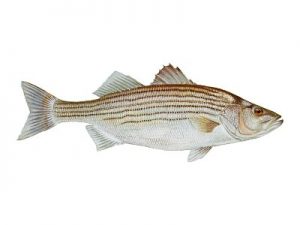
Preliminary results from an ongoing long-term survey conducted by researchers at the Virginia Institute of Marine Science suggest an average year class of young-of-year striped bass was produced in Virginia tributaries of the Chesapeake Bay in 2019.
The 2019 year class represents the group of fish hatched this spring that will grow to fishable sizes in three to four years.
The program, formally known as the Juvenile Striped Bass Seine Survey, recorded a mean value (recruitment index) of 9.54 fish per seine haul in the Virginia portion of the Chesapeake Bay, which is similar to the historic average of 7.77 fish per seine haul. The 2019 value was also similar to indices observed in the past six years.
Although there can be considerable variation in striped bass recruitment among years, the average indices observed in recent years suggests that abundance of juvenile striped bass has been stable.
Striped bass play an important role as a top predator in the Chesapeake Bay ecosystem and are a valuable resource for commercial and recreational anglers.
The VIMS Juvenile Striped Bass Seine Survey currently samples 18 index stations in the Rappahannock, York, and James River watersheds.
Biologists sampled each site 5 times from mid-June to late August in 2019, deploying a 30.5 m-long (100-foot) seine net from the shore.
Each fish captured in the net is counted, measured, and returned to the water. These young striped bass usually measure between 40 and 100 mm (1.5-4 inches) long. Survey scientists in Virginia measured 1,624 juvenile striped bass at these stations in 2019.
VIMS has been conducting the survey annually since 1967 for the Virginia Marine Resources Commission (VMRC).
The Maryland Department of Natural Resources conducts a similar survey in the northern portion of the Bay, and this year documented a below-average index.
The striped bass population in Chesapeake Bay has rebounded from historic lows in the late 1970s and early 1980s, after fishing bans were enacted in Delaware, Maryland, and Virginia in the mid- to late-1980s.
Since then, the population increased to the point that striped bass in the Bay and elsewhere were considered recovered. In 2019, scientists determined that the striped bass population was overfished and that mortality due to fishing was higher than what the population can withstand in the long term.
Monitoring of juvenile striped bass recruitment will continue next year to provide managers with crucial information to sustainably manage this important species.
source: Virginia Institute of Marine Science
Related Information